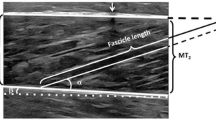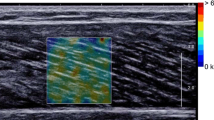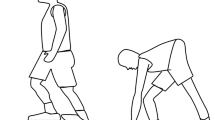Abstract
Static stretch is commonly used to prevent contracture and to improve joint mobility. However, it is unclear whether the components of the muscle-tendon unit are affected by a static stretch training program. This study investigated the effect of a four-week static stretch training program on the viscoelastic properties of the muscle-tendon unit and muscle. The subjects comprised 18 male participants (mean age 21.4 ± 1.7 years). The range of motion (ROM), passive torque, myotendinous junction (MTJ) displacement and, muscle fascicle length of the gastrocnemius muscle were assessed using both ultrasonography and a dynamometer while the ankle was passively dorsiflexed. After the initial test, the participants were assigned either to a group that stretched for 4 weeks (N = 9) or to a control group (N = 9). The tests were repeated after the static stretch training program. The ROM and MTJ displacement significantly increased, and the passive torque at 30° significantly decreased, in the stretching group after the study period. However, there was no significant increase in muscle fascicle length. These results suggest that a 4-week static stretch training program changes the flexibility of the overall MTU without causing concomitant changes in muscle fascicle length.


Similar content being viewed by others
References
Ben M, Harvey LA (2010) Regular stretch does not increase muscle extensibility: a randomized controlled trial. Scand J Med Sci Sports 20:136–144
Bjorklund M, Hamberg J, Crenshaw AG (2001) Sensory adaptation after a 2-week stretching regimen of the rectus femoris muscle. Arch Phys Med Rehabil 82:1245–1250
Chan SP, Hong Y, Robinson PD (2001) Flexibility and passive resistance of the hamstrings of young adults using two different static stretching protocols. Scand J Med Sci Sports 11:81–86
Covert CA, Alexander MP, Petronis JJ, Davis DS (2010) Comparison of ballistic and static stretching on hamstring muscle length using an equal stretching dose. J Strength Cond Res 24:3008–3014
Feland JB, Myrer JW, Schulthies SS, Fellingham GW, Measom GW (2001) The effect of duration of stretching of the hamstring muscle group for increasing range of motion in people aged 65 years or older. Phys Ther 81:1110–1117
Folpp H, Deall S, Harvey LA, Gwinn T (2006) Can apparent increases in muscle extensibility with regular stretch be explained by changes in tolerance to stretch? Aust J Physiother 52:45–50
Gajdosik RL (1991) Effects of static stretching on the maximal length and resistance to passive stretch of short hamstring muscles. J Orthop Sports Phys Ther 14:250–255
Gajdosik RL (2001) Passive extensibility of skeletal muscle: review of the literature with clinical implications. Clin Biomech 16:87–101
Goldspin G, Tabary C, Tabary JC, Tardieu C, Tardieu G (1974) Effect of denervation on adaptation of sarcomere number and muscle extensibility to functional length of muscle. J Physiol 236:733–742
Kubo K, Kanehisa H, Fukunaga T (2002) Effect of stretching training on the viscoelastic properties of human tendon structures in vivo. J Appl Physiol 92:595–601
Kumagai K, Abe T, Brechue WF, Ryushi T, Takano S, Mizuno M (2000) Sprint performance is related to muscle fascicle length in male 100-m sprinters. J Appl Physiol 88:811–816
Maganaris CN, Paul JP (1999) In vivo human tendon mechanical properties. J Physiol 521:307–313
Magnusson SP, Simonsen EB, Aagaard P, Kjaer M (1996a) Biomechanical responses to repeated stretches in human hamstring muscle in vivo. Am J Sports Med 24:622–628
Magnusson SP, Simonsen EB, Aagaard P, Sorensen H, Kjaer M (1996b) A mechanism for altered flexibility in human skeletal muscle. J Physiol 497:291–298
Mahieu NN, McNair P, De Muynck M, Stevens V, Blanckaert I, Smits N, Witvrouw E (2007) Effect of static and ballistic stretching on the muscle-tendon tissue properties. Med Sci Sports Exerc 39:494–501
Marques AP, Vasconcelos AA, Cabral CM, Sacco IC (2009) Effect of frequency of static stretching on flexibility, hamstring tightness and electromyographic activity. Braz J Med Biol Res 42:949–953
McHugh MP, Kremenic IJ, Fox MB, Gleim GW (1998) The role of mechanical and neural restraints to joint range of motion during passive stretch. Med Sci Sports Exerc 30:928–932
Morse CI, Degens H, Seynnes OR, Maganaris CN, Jones DA (2008) The acute effect of stretching on the passive stiffness of the human gastrocnemius muscle tendon unit. J Physiol 586:97–106
Purslow PP (1989) Strain-induced reorientation of an intramuscular connective tissue network: implications for passive muscle elasticity. J Biomech 22:21–31
Reid DA, McNair PJ (2004) Passive force, angle, and stiffness changes after stretching of hamstring muscles. Med Sci Sports Exerc 36:1944–1948
Santonja Medina FM, Sainz De Baranda Andujar P, Rodriguez Garcia PL, Lopez Minarro PA, Canteras Jordana M (2007) Effects of frequency of static stretching on straight-leg raise in elementary school children. J Sports Med Phys Fitness 47:304–308
Tabary JC, Tabary C, Tardieu G, Tardieu C, Goldspin G (1972) Physiological and Structural Changes in Cats Soleus Muscle Due to Immobilization at Different Lengths by Plaster Casts. J Physiol 224:231–244
Toft E, Espersen GT, Kalund S et al (1989) Passive tension of the ankle before and after stretching. Am J Sports Med 17:489–494
Weppler CH, Magnusson SP (2010) Increasing muscle extensibility: a matter of increasing length or modifying sensation? Phys Ther 90:438–449
Williams PE, Goldspink G (1978) Changes in sarcomere length and physiological properties in immobilized muscle. J Anat 127:459–468
Willy RW, Kyle BA, Moore SA, Chleboun GS (2001) Effect of cessation and resumption of static hamstring muscle stretching on joint range of motion. J Orthop Sports Phys Ther 31:138–144
Ylinen J, Kankainen T, Kautiainen H, Rezasoltani A, Kuukkanen T, Hakkinen A (2009) Effect of stretching on hamstring muscle compliance. J Rehabil Med 41:80–84
Conflict of interest
The authors have no conflicts of interest to declare.
Author information
Authors and Affiliations
Corresponding author
Additional information
Communicated by Jean-René Lacour.
Rights and permissions
About this article
Cite this article
Nakamura, M., Ikezoe, T., Takeno, Y. et al. Effects of a 4-week static stretch training program on passive stiffness of human gastrocnemius muscle-tendon unit in vivo. Eur J Appl Physiol 112, 2749–2755 (2012). https://doi.org/10.1007/s00421-011-2250-3
Received:
Accepted:
Published:
Issue Date:
DOI: https://doi.org/10.1007/s00421-011-2250-3




